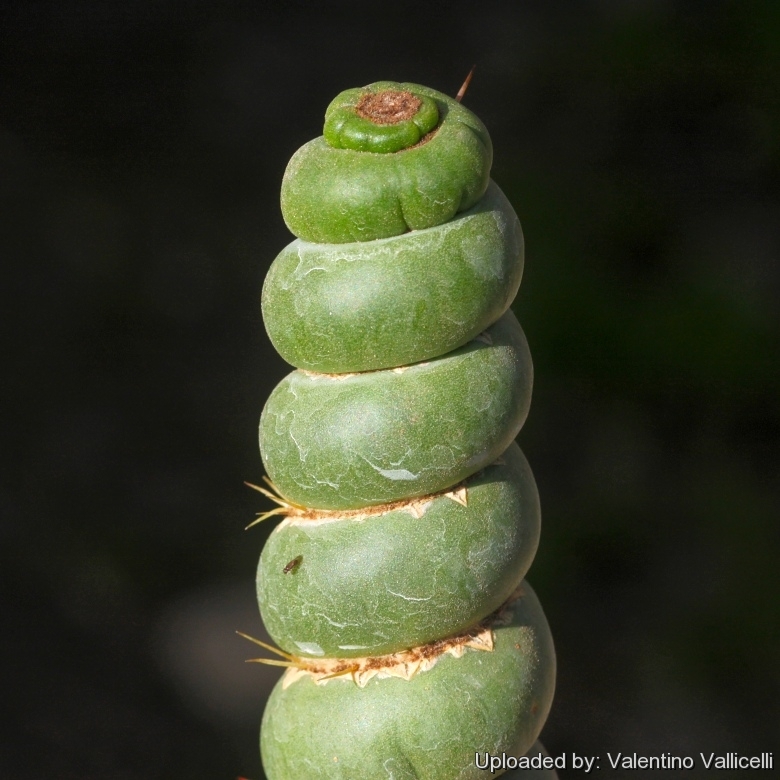
Eulychnia castanea cv. varispiralis spiral form Photo by: Valentino Vallicelli
Origin and Habitat: Garden origin (Nursery produced cultivar)
Synonyms:
See all synonyms of Eulychnia castanea
back
Accepted name in llifle Database:Eulychnia castanea (K.Schum.) Phil.Linnaea 33: 80. 1864Synonymy: 3
Cultivars
(4):
back
Description: This odd plant is known in cultivation under quite a lot of different names (among them, "spiralis", "varispiralis", "spiraliforme", "mostruosa", "monstrose", "monstrous" ) It is a variable cultivar of which we can distinguish at least four basic growing forms:
1) Columnar monstrous form: Characterized by a lumpy-bumpy monstrous surface, this is the more common form, about 60-75% of the new branch shows this monstrous morphology.
2) Columnar discoidal form: Characterized by green discs placed one on top of another in a heap. Only 20-30% of branches develop the typical discs.
3) Columnar spiral form: Characterized by curly, whirly spiral growth that can be equally dextrorotatory or levorotatory, this form is very appreciated by collectors but comparatively rare (about 5-15% of shots shows this admirable feature)
4) Crested form: Characterized by fan-like sculptural shapes comprising mix of the previously types, this form is very rare and prized.
Remarks: All this form are only growing variant of the same clone, each new branch must show one (or a mix) of the four growing mode and each plant is unique and different.
Subspecies, varieties, forms and cultivars of plants belonging to the Eulychnia castanea group
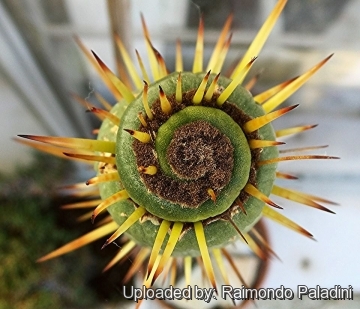 Eulychnia castanea cv. varispiralis spiral form Photo by: Raimondo Paladini
Eulychnia castanea cv. varispiralis spiral form Photo by: Raimondo Paladini Eulychnia castanea cv. varispiralis spiral form Photo by: Flavio Agrosi
Eulychnia castanea cv. varispiralis spiral form Photo by: Flavio Agrosi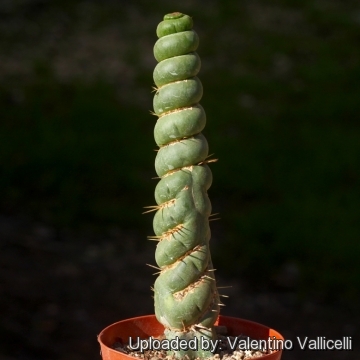 Eulychnia castanea cv. varispiralis spiral form Photo by: Valentino Vallicelli
Eulychnia castanea cv. varispiralis spiral form Photo by: Valentino Vallicelli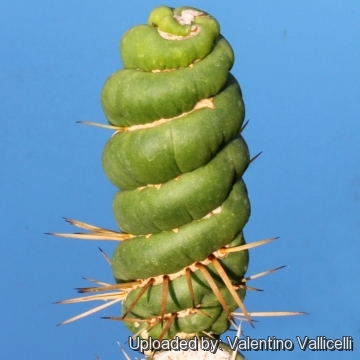 - This form is characterized by curly, whirly spiral growth that can be equally dextrorotatory or levorotatory, this form is very appreciated by collectors but comparatively rare (about 5-15% of shots shows this admirable feature) Photo by: Valentino Vallicelli
- This form is characterized by curly, whirly spiral growth that can be equally dextrorotatory or levorotatory, this form is very appreciated by collectors but comparatively rare (about 5-15% of shots shows this admirable feature) Photo by: Valentino Vallicelli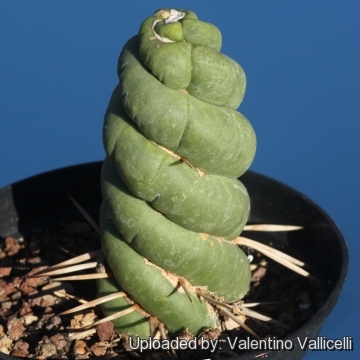 Eulychnia castanea cv. varispiralis spiral form Photo by: Valentino Vallicelli
Eulychnia castanea cv. varispiralis spiral form Photo by: Valentino Vallicelli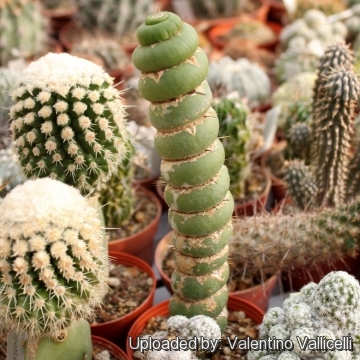 Eulychnia castanea cv. varispiralis spiral form Photo by: Valentino Vallicelli
Eulychnia castanea cv. varispiralis spiral form Photo by: Valentino Vallicelli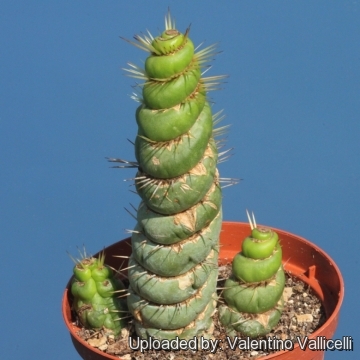 Eulychnia castanea cv. varispiralis spiral form Photo by: Valentino Vallicelli
Eulychnia castanea cv. varispiralis spiral form Photo by: Valentino Vallicelli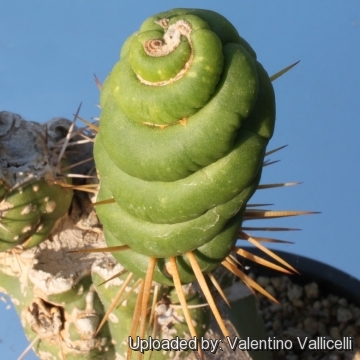 Eulychnia castanea cv. varispiralis spiral form Photo by: Valentino Vallicelli
Eulychnia castanea cv. varispiralis spiral form Photo by: Valentino VallicelliCultivation and Propagation: This species presents no problems in cultivation and will do well in a sunny spot in a cactus house. These plants will tolerate sun and heat, but not extended periods of frost. The crested form is more frost sensitive and should not be kept at less than -0°C . Grow them in rich, porous, sandy soil, and let their soil dry out between waterings. If potted, repot in the spring, if their roots become cramped. Generally, they should be repotted every other year in order to provide fresh soil. However, this doesn't necessarily mean they'll need larger containers. Fill about a quarter of the pot with broken crocks, gravel, etc. to promote good drainage. After repotting, do not water for a week or more. The crested plants enjoy a warm sunny environment and for more speedy growth a light position on a higher shelf with light feeding and rainwater given to the bottom of the plant will ensure success, especially with rooted detached branches, which do well in these conditions.
Propagation: This plant is frequently grafted onto a Myrtillocactus geometrizansSN|8050]]SN|8050]] trunk, but it is easily grown on its own roots. It can be increased by cuttings, which will take root in a minimum temperature of 20° C. Cuttings of healthy shoots can be taken in the spring and summer, Cut the stem with a sharp, sterile knife, leave the cutting in a warm, dry place for a week or weeks (depending on how thick the cutting is) until a callus forms over the wound. Once the callus forms, the cutting may be inserted in a container filled with firmed cactus potting mix topped with a surface layer of coarse grit. They should be placed in the coarse grit only; this prevents the cut end from becoming too wet and allows the roots to penetrate the rich compost underneath. The cuttings should root in 2 to 6 weeks.
Your Photos
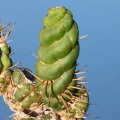
by Valentino Vallicelli



















